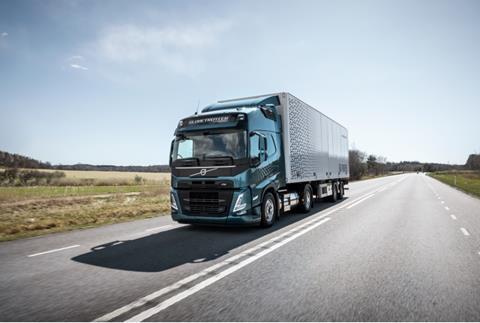Volvo Trucks is currently introducing a new, more powerful gas-powered vehicle running on liquified biogas and offering 500hp.

Volvo Trucks has unveiled a new 500hp version of its bio-LNG truck line-up. The LNG trucks, original launched five years ago in 420 and 460hp variants, now gets a power boost. The gas engines have also undergone major technical upgrades, increasing fuel efficiency by up to 4% and boasting a 10% larger gas tank, resulting in a longer range for the trucks.
“Biogas is a great complement to electric transport, helping hauliers with their sustainability goals and efforts towards climate-neutral transport,” says Daniel Bergstrand, product manager for gas-powered trucks at Volvo Trucks. Our efficient gas-powered trucks have a performance comparable to their diesel equivalents. Refueling is almost as fast as a diesel truck and the growing network of over 600 fuel stations for both bio-LNG and LNG in Europe make them ideal for long-haul transports,” explains Bergstrand.
The strengthened gas-powered line-up aligns with Volvo Trucks’ three-path strategy to reach zero emissions: battery electric trucks, fuel cell trucks, and combustion engines powered by renewable fuels such as biogas, HVO, or green hydrogen.

“Several technical solutions are needed because the availability of energy and fuel infrastructure differs greatly between countries and regions, and also because the requirements for each transport assignment can vary,” comments Bergstrand.
Europe is ramping up production of bio-LNG to replace fossil LNG, with the EU Commission’s REPower EU plan aimed at boosting annual biogas production ten times by 2030. The biogas sector is already in a rapid growth phase and the potential for biogas is gaining interest globally.
Volvo’s gas-powered trucks are available in three product models: Volvo FH, FM, and FMX. The power levels offered are 420, 460 and 500 hp, and the trucks run on bio-LNG (liquified biogas) or LNG, with a small amount of diesel or HVO used to ignite the gas. The range of these trucks can go up to 1000km between refills. The engine technology utilised by these trucks allows for the same drivability as a diesel truck, which makes it possible to run with high loads and cover long distances. The new gas-powered Euro-6 step E engines are also up to 4% more fuel efficient than the step D engines. This increased efficiency is achieved through new injectors and pistons for reduced friction, a new turbo, variable oil pump, and a Crank Case Ventilation system that handles unfiltered oil.
Bio-LNG (liquid biogas) is a renewable fuel produced from the digestion of organic waste such as sludge from treatment plants, food waste, manure, and other residual products. On the other hand, LNG (Liquified Natural Gas) is a fossil gas (methane) extracted from underground or undersea reserves. The process of liquifying biogas is the same as for LNG and involves cooling the gas down to –162°C, which reduces its volume and increases the amount of energy that can be stored onboard the truck. The EU Commission’s goal (REPower EU) is to increase annual biogas production ten-fold to 35 billion cubic meters by 2030. 78 bio-LNG plants are already confirmed to be ready in Europe by 2024, with Germany, Italy, and the Netherlands expected to be the leading bio-LNG countries in the coming years


















